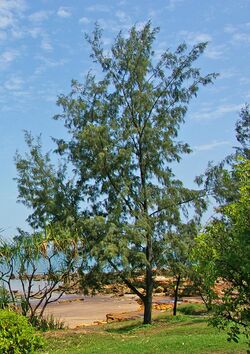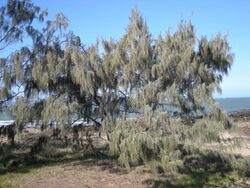Biology:Casuarina equisetifolia
| Casuarina equisetifolia | |
|---|---|

| |
| Subspecies equisetifolia near Darwin | |
| Scientific classification | |
| Kingdom: | Plantae |
| Clade: | Tracheophytes |
| Clade: | Angiosperms |
| Clade: | Eudicots |
| Clade: | Rosids |
| Order: | Fagales |
| Family: | Casuarinaceae |
| Genus: | Casuarina |
| Species: | C. equisetifolia
|
| Binomial name | |
| Casuarina equisetifolia | |
| Subspecies | |
| |
| Synonyms[2] | |
|
Casuarina equisetifolia var. typica Domin | |
Casuarina equisetifolia, commonly known as coastal she-oak, horsetail she-oak,[3] ironwood,[4] beach sheoak, beach casuarina or whistling tree [5] is a species of flowering plant in the family Casuarinaceae and is native to Australia, New Guinea, Southeast Asia and India. It is a small to medium-sized, monoecious tree with scaly or furrowed bark on older specimens, drooping branchlets, the leaves reduced to scales in whorls of 7 or 8, the fruit 10–24 mm (0.39–0.94 in) long containing winged seeds (samaras) 6–8 mm (0.24–0.31 in) long.
Description
Casuarina equisetifolia is a monoecious tree that typically grows to a height of 6–12 m (20–39 ft), sometimes to 35 m (115 ft), and has bark that is smooth and greyish on young specimens, scaly or furrowed on older trees. The branchlets are drooping, up to 300 mm (12 in) long, the leaves reduced to scale-like teeth about 0.7 mm (0.028 in) long, arranged in whorls of 7 or 8 around the branchlets. The sections of branchlet between the leaf whorls (the "articles") are 5–13 mm (0.20–0.51 in) long and 0.5–1.0 mm (0.020–0.039 in) wide. Male flowers are arranged in spikes 7–40 mm (0.28–1.57 in) long in whorls of 7 to 11.5 per centimetre (per 0.39 in.) the anthers 0.6–0.8 mm (0.024–0.031 in) long. The female cones are on a peduncle 3–13 mm (0.12–0.51 in) long and sparsely covered with soft or woolly hairs. Mature cones are 10–24 mm (0.39–0.94 in) long and 9–13 mm (0.35–0.51 in) in diameter, the samaras 6–8 mm (0.24–0.31 in) long.[3][5][6]
Common names for the tree include Australian pine, horsetair tree, ironwood, beach sheoak; although it has features that seem superficially like a conifer, it is not a pine.[7]
Taxonomy
The genus Casuarina was first formally described in 1759 by Carl Linnaeus in Amoenitates Academicae and the first species he described was Casuarina equisetifolia.[8][9] The specific epithet (equisetifolia) means "horsehair-leaved".[5]
In 1873, George Bentham described Casuarina equisetifolia var. incana and C. equisetifolia var. equisetifolia in Flora Australiensis.[10] and in 1982, Lawrie Johnson changed the names to subspecies equisetifolia and incana respectively, in the Journal of the Adelaide Botanic Gardens:[11]
- Casuarina equisetifolia L. subsp. equisetifolia,[12] a tree 7–35 m (23–115 ft) high, the articles 5–8 mm (0.20–0.31 in) long and 0.5–0.7 mm (0.020–0.028 in) with 8 to 10 teeth 0.3–0.8 mm (0.012–0.031 in) long, the male spikes 7–40 mm (0.28–1.57 in) long, the cones 12–24 mm (0.47–0.94 in) long and 9–11 mm (0.35–0.43 in) wide on a peduncle 3–10 mm (0.12–0.39 in) long.[13]
- Casuarina equisetifolia subsp. incana (Benth.) L.A.S.Johnson.[14] a tree 6–12 m (20–39 ft) high, the articles 7–13 mm (0.28–0.51 in) long and 0.7–1.0 mm (0.028–0.039 in) with 8 to 10 teeth about 0.7 mm (0.028 in) long, the male spikes 12–25 mm (0.47–0.98 in) long, the cones 10–20 mm (0.39–0.79 in) long, 10–13 mm (0.39–0.51 in) wide and densely covered with white to rust-coloured hairs, on a peduncle 3–13 mm (0.12–0.51 in) long.[3][15] The epithet incana means "white" or "hoary".[16]
There is some doubt as to whether Linnaeus' publication of C. equisetifolia is valid, since he based his description solely on Rumphius's description of Casuarina litorea in Herbarium Amboinense[17] and there are no type specimens.[18]
Distribution and habitat
Casuarina equisetifolia subsp. equisetifolia grows near the sea, behind beaches and near estuaries, sometimes on rocky headlands in Australia, New Guinea, Southeast Asia and India.[2][5] The species is native to India and Bangladesh in South Asia, Myanmar, the Andaman Islands, Nicobar Islands, Vietnam, Thailand, Cambodia, Peninsular Malaysia, the Philippines , Borneo, Java and the Lesser Sunda Islands, islands in the South China Sea, Sulawesi and Sumatra in Southeast Asia, the Carolines, Fiji, the Marianas, the Marshall Islands, New Caledonia, Samoa, Solomon Islands, Tonga, Tuvalu and Vanuatu in the Pacific Ocean, New Guinea, and New South Wales, the Northern Territory, and Queensland in Australia.[2][5][13]
Subspecies incana grows on rocky headlands near the coasts of eastern Queensland and New South Wales as far south as Laurieton.[3][5][15][19]
Casuarina equisetifolia has been introduced to many other continents and islands.[2] It is an invasive species in the United States, but biological control by insects, including by a Selitrichodes wasp and Carposinidae and Gelechiidae moths has been effective.[20][21][22] It is also regarded as being invasive in South Africa.[23]
Uses
Other than ornamental purposes, Casuarina was also explored in for its potential in remediation of textile dye wastewater. Casuarina leaves were found to be useful as absorbent material for the removal of textile dyes such as reactive orange 16[24] Rhodamine B,[25] methylene blue, malachite green[26] and methyl violet 2b.[27] Similarly the Casuarina dried cone was also reported to be able to remove Rhodamine B,[28] and methyl violet 2b.[29] The Casuarina bark was reported to able to remove methylene blue.[30] Even the Casuarina seed was also found to be useful in dye removal of neutral red and malachite green.[31] The carbon derived from the cones of Casuarina was found to be good absorbent for the landfill leachate,[32] while another laboratory also reported good absorbent for copper ions from aqueous solution.[33]
Culture
Names of places
In Singapore, there is a road named Tanjong Rhu Road because it once had many of these trees growing along the coast from Kallang to Rochor.[34] In the island of Langkawi, Kedah, Malaysia, there is a sand spit in the mouth of the Ayer Hangat river in the Kilim Karst Geoforest Park about 20 km from the town of Kuah also named Tanjung Rhu where these trees line here.[35] The town of Tanjung Aru in Sabah is also named because a lot of this tree (aru) is found in its beach.[36]
In the Philippines , the town of Agoo is named after the tree (known as agoho or aroo in the Ilocano language).[37]
Gallery
See also
- Pinus kesiya, the Khasi or Benguet pine
- Allelopathy
References
- ↑ Barstow, M. (2019). "Casuarina equisetifolia". IUCN Red List of Threatened Species 2019: e.T16728404A16728408. https://www.iucnredlist.org/species/16728404/16728408. Retrieved 26 December 2023.
- ↑ 2.0 2.1 2.2 2.3 2.4 "Casuarina equisetifolia". Plants of the World Online. https://powo.science.kew.org/taxon/urn:lsid:ipni.org:names:159856-1#synonyms.
- ↑ 3.0 3.1 3.2 3.3 Wilson, Karen L.; Johnson, Lawrence A.S.. "Casuarina equisetifolia subsp. incana". Royal Botanic Garden Sydney. https://plantnet.rbgsyd.nsw.gov.au/cgi-bin/NSWfl.pl?page=nswfl&lvl=sp&name=Casuarina~equisetifolia.
- ↑ "Casuarina equisetifolia - Common Ironwood, Beach Sheoak, Horsetail Casuarina, Australian Pine, Australian Beefwood - Hawaiian Plants and Tropical Flowers" (in en-US). 2009-12-24. https://wildlifeofhawaii.com/flowers/774/casuarina-equisetifolia-common-ironwood/.
- ↑ 5.0 5.1 5.2 5.3 5.4 5.5 Boland, Douglas J.; Brooker, M. I. H.; Chippendale, G. M.; McDonald, Maurice William (2006). Forest trees of Australia. Collingwood, Victoria: CSIRO Publishing. p. 82. ISBN 0-643-06969-0. https://books.google.com/books?id=q2v3kb9tFsYC&pg=PA82.
- ↑ "Casuarina equisetifolia". Australian Biological Resources Study, Department of Agriculture, Water and the Environment: Canberra. https://profiles.ala.org.au/opus/foa/profile/Casuarina%20equisetifolia.
- ↑ "Casuarina equisetifolia | Landscape Plants | Oregon State University". https://landscapeplants.oregonstate.edu/node/2144.
- ↑ "Casuarina". APNI. https://id.biodiversity.org.au/instance/apni/457715.
- ↑ Linnaeus, Carl (1759). Amoenitates academicae, seu, Dissertationes variae physicae, medicae, botanicae. p. 143. https://www.biodiversitylibrary.org/item/15496#page/146/mode/1up. Retrieved 29 April 2023.
- ↑ Bentham, George (1873). Flora Australiensis. 6. London: Lovell Reeve & Co.. p. 197. https://www.biodiversitylibrary.org/item/44539#page/203/mode/1up. Retrieved 29 April 2023.
- ↑ Johnson, Lawrence A.S. (1982). "Notes on Casuarinaceae II.". Journal of the Adelaide Botanic Gardens 6 (1): 79. https://www.biodiversitylibrary.org/page/61978679#page/91/mode/1up. Retrieved 29 April 2023.
- ↑ "Casuarina equisetifolia subsp. equisetifolia". https://biodiversity.org.au/nsl/services/apc-format/display/55877.
- ↑ 13.0 13.1 "Casuarina equisetifolia subsp. equisetifolia". Australian Biological Resources Study, Department of Agriculture, Water and the Environment: Canberra. https://profiles.ala.org.au/opus/foa/profile/Casuarina%20equisetifolia.
- ↑ "Casuarina equisetifolia subsp. incana". https://biodiversity.org.au/nsl/services/apc-format/display/55881.
- ↑ 15.0 15.1 "Casuarina equisetifolia subsp. incana". Australian Biological Resources Study, Department of Agriculture, Water and the Environment: Canberra. https://profiles.ala.org.au/opus/foa/profile/Casuarina%20equisetifolia.
- ↑ William T. Stearn (1992). Botanical Latin. History, grammar, syntax, terminology and vocabulary (4th ed.). Portland, Oregon: Timber Press. p. 431.
- ↑ Rumphius, Georg E. (1743). Herbarium Amboinense. 3. Amsterdam. p. 86. https://www.biodiversitylibrary.org/item/10353#page/142/mode/1up. Retrieved 29 April 2023.
- ↑ Wilson, Karen L.; Johnson, Lawrence A.S. (1989). Flora of Australia. Canberra: Australian Government Publishing Service. p. 201. https://www.dcceew.gov.au/sites/default/files/env/pages/a08d125d-a6d0-47c4-85e9-9b7ac5d4931a/files/flora-australia-03-hamamelidales-casuarinales.pdf. Retrieved 29 April 2023.
- ↑ "Casuarina equisetifolia". World Agroforestry (Centre for International Forestry Research). https://apps.worldagroforestry.org/treedb2/AFTPDFS/Casuarina_equisetifolia.PDF.
- ↑ "Biological control of Australian native Casuarina species in the USA". Commonwealth Scientific and Industrial Research Organisation. 16 May 2007. http://www.csiro.au/science/ps334.html.
- ↑ Masterson, J (4 October 2007). "Casuarina equisetifolia (Australian Pine)". Fort Pierce: Smithsonian Marine Station. http://www.sms.si.edu/irlspec/Casuarina_equisetifolia.htm.
- ↑ Purcell, Matthew. "Evaluating Biological Control Agents of Australian Pine". United States Department of Agriculture. https://www.ars.usda.gov/office-of-international-research-engagement-and-cooperation/overseas-biological-control-obcl-highlights/evaluating-biological-control-agents-of-australian-pine/.
- ↑ "SANBI:Declared Weeds & Invader Plants". South African National Biodiversity Institute. http://www.plantzafrica.co.za/miscell/aliens3.htm.
- ↑ Bharti, Vikash; Shahi, Amrita; Geed, Sachin; Kureel, M.K. (2017). "Biodegradation of reactive orange 16 dye in the packed bed bioreactor using seeds of Ashoka and Casuarina as packing media". Indian Journal of Biotechnology 16: 216–221.
- ↑ Kooh, Muhammad Raziq Rahimi; Dahri, Muhammad Khairud; Lim, Linda B.L. (2016). "The removal of rhodamine B dye from aqueous solution using Casuarina equisetifolia needles as absorbent". Cogent Environmental Science 2. doi:10.1080/23311843.2016.1140553.
- ↑ Dahri, Muhammad Khairud; Kooh, Muhammad Raziq Rahimi; Lim, Linda B.L. (2015). "Application of Casuarina equisetifolia needle for the removal of methylene blue and malachite green dyes from aqueous solution". Alexandria Engineering Journal 54 (4): 1253. doi:10.1016/j.aej.2015.07.005.
- ↑ Dahri, Muhammad Khairud; Kooh, Muhammad Raziq Rahimi; Lim, Linda B. L. (2013). "Removal of Methyl Violet 2B from Aqueous Solution Using Casuarina equisetifolia Needle". ISRN Environmental Chemistry 2013: 1–8. doi:10.1155/2013/619819.
- ↑ Dahri, Muhammad Khairud; Kooh, Muhammad Raziq Rahimi; Lim, Linda B. L. (2016). "Remediation of Rhodamine B Dye from Aqueous Solution Using Casuarina equisetifolia Cone Powder as a Low-Cost Absorbent". Advances in Physical Chemistry 2016: 1–7. doi:10.1155/2016/9497378.
- ↑ "Water remediation using Casuarina equisetifolia cone as adsorbent for the removal of methyl violet 2B dye using batch experiment method". Journal of Environment & Biotechnology Research 6 (1): 34–42. January 2017. http://www.vinanie.com/jebr/articles/v6n1p34.html.
- ↑ Adsorption of methylene blue by casuarina equisetifolia bark. http://en.cnki.com.cn/Article_en/CJFDTOTAL-ZKZX201006017.htm. Retrieved 2018-02-15.
- ↑ "Application of microwave-treated Casuarina equisetifolia seeds in adsorption of dyes". Journal of Fundamental and Applied Sciences 9: 458–471. 2017. doi:10.4314/JFAS.V9I7S.43. ISSN 1112-9867. http://jfas.info/psjfas/index.php/jfas/article/view/3342.
- ↑ Alrozi, Rasyidah; Zubir, Nor Aida; Kamaruddin, Mohamad Anuar; Yusof, Siti Noor Faizah Mohd; Yusoff, Mohd Suffian (2017). "Removal of organic fractions from landfill leachate by Casuarina equisetifolia activated carbon: Characteristics and absorption mechanisms". AIP Conference Proceedings 1885 (1): 020139. doi:10.1063/1.5002333. Bibcode: 2017AIPC.1885b0139A.
- ↑ Muslim, A. (2017). "AUSTRALIAN PINE CONES-BASED ACTIVATED CARBON FOR ADSORPTION OF COPPER IN AQUEOUS SOLUTION". Journal of Engineering Science and Technology 12 (2): 280–295. http://jestec.taylors.edu.my/Vol%2012%20issue%202%20February%202017/12_2_1.pdf.
- ↑ Thulaja, Naidu Ratnala (24 January 2018). "Tanjong Rhu Road". Government of Singapore. https://eresources.nlb.gov.sg/infopedia/articles/SIP_625_2004-12-31.html.
- ↑ "Tanjung Rhu". The Cooperative of Kilim Village Community Langkawi Limited. 2022. https://kilimgeoforestpark.com/geosites/tanjung-rhu/.
- ↑ "'Replant Aru trees, mangroves at Tanjung Aru blaze site' call". Daily Express. 22 July 2021. https://www.dailyexpress.com.my/news/174931/replant-aru-trees-mangroves-at-tanjung-aru-blaze-site-call/.
- ↑ Sals, Florent Joseph (2005) (in en). The History of Agoo: 1578-2005. La Union: Limbagan Printhouse. pp. 80.
External links
| Wikimedia Commons has media related to Casuarina equisetifolia. |
- NT Flora: Casuarina equisetifolia. Northern Territory Government.
Wikidata ☰ {{{from}}} entry
 |







